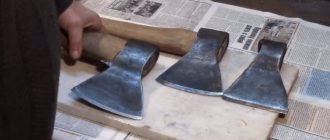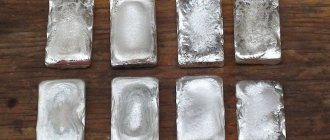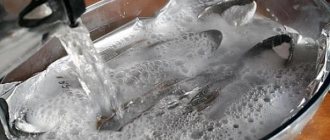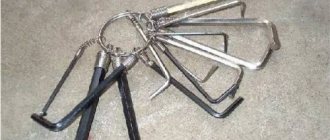Corrosion protection
This is the most important goal. This is especially true when a metal structure is used outdoors, that is, the steel is constantly exposed to oxygen and moisture. With such actively reacting substances, an oxidative process - rusting - is possible. As a result, red rust is formed. It greatly affects the strength, reducing it, and also shortens the service life. In this regard, many car enthusiasts are actively interested in how to make the surface of the metal black, and how to blue the steel elements of the car, since corrosion spoils automobile spare parts.
Give the product a presentable look
A dark matte shade can give a stylish design to an ordinary knife. The blade, coated with an oxide film, looks very unusual and attractive. The same can be said for a number of other items. This need is especially relevant when the item is already old.
The technology is also used for artistic purposes, when a creative approach is taken to decorative elements of the interior.
Popular methods
Before we move on to specific techniques that are used in production or at home, we will talk about the stages. They almost always remain the same:
- Preparatory. It is necessary to carefully prepare the part, remove any contamination from the surface and from the holes, before blueing the metal at home. If there are scales or other raised parts, they can be smoothed out using sanding paper. If you use liquid media, be sure to dry the workpiece at the preliminary stage.
- Degreasing. This especially applies to car parts. As a rule, they have a thin oil layer on them, which must first be removed. If there is an oily layer between the steel and the active substance, the chemical solution, the reaction will not occur at all or will be incomplete, with disturbances. Even the slightest traces of oily media should be removed. For example, fingerprints on the handle of a knife, which remain due to the work of the sebaceous glands. Therefore, you should always work with gloves.
- Application of the composition. Below we will tell you more about how you can apply the mass. There are also ways to completely immerse a part.
- Finishing processing. It includes washing the workpiece, drying, and light cleaning if any errors appear.
At home, you can carry out cold and hot bluing of metal: how to blued steel at home, we will present videos that show the three most common options.
Alkaline
The process will produce gas. It has an unpleasant odor and is also dangerous if inhaled in excess. Therefore, it is very important to provide yourself with a suitable workplace - an open space with good ventilation. A garage will do if the doors and windows are open and you are wearing a construction respirator that will protect you from inhaling toxic fumes.
Once you've prepared the area, it's time to find the container. It must be spacious so that the object prepared for the procedure fits completely inside and does not touch the walls of the vessel. Manufacturing material – stainless steel. Let's say it's a large saucepan or metal bucket.
After preliminary degreasing of the surface, we recommend hanging the workpiece by thin threads or wire so that you can move it without touching it with your hands.
Now we apply the solution for bluing. We suggest a small experiment with 100 ml of water (suddenly you need to blacken, say, a nail), but for larger products you should prepare a similar composition, only adhering to the proportions. So, pour 0.1 liter of liquid (bottled, without impurities), dissolve caustic soda in it (caustic soda, sodium hydroxide, NaOH - there are many names, you can buy it at any hardware store) in the amount of 120 grams. Plus we add literally 30 g of sodium nitrate. It is very important to mix well so that when mixing the consistency is homogeneous and without sediment.
When the liquid is ready, place the container on the stove. We heat it to 130–150 degrees. We note right away that you will also need a thermometer adapted to such high temperatures. The mixture will begin to boil, and it will be possible to place an object into it in a pre-specified manner (so that it is completely immersed and does not touch the walls). Wait 20 minutes.
During this period of time, a black oxide film is formed. Now you can rinse the product removed from the solution in ordinary water for quick cooling.
After drying, we recommend taking machine oil and a clean piece of cloth. They should wipe the surface and make it dry. Because of this, you get a top layer that has increased wear resistance and smoothness. If everything was done correctly, polishing will not be required.
Let us note once again the important rules:
- the workpiece must be completely immersed in the vessel;
- When working, use gloves and a respirator.
In case of uneven immersion, you may not get the result you expect: the color will not be the same, but with transitions from lighter to darker.
Acid oxidation of metal at home
The use of acids is a dangerous process that can cause chemical burns on the skin and mucous membranes, so you need to protect yourself reliably. Be sure to wear safety glasses. The second important rule when using this blackening technology is careful adherence to the preparatory stage. Any traces of corrosion should be removed. Rust can be easily cleaned with sandpaper (first coarse-grained, then fine-grained). If the corrosion damage or contamination is very deep and has a large area, then it would be appropriate to use an angle grinder with an attachment (metal brush).
Then cleaners, for example, based on sodium triphosphate and ethyl alcohol, help well. Kerosene is also a good way to deal with greasy stains. You can soak it in it for about 10–15 minutes, then rinse it with running water and dry it at room temperature in a room where dust will not actively settle. While drying, prepare a solution for blackening the metal. For one liter of water you will need only 2 grams of tannic and tartaric acid.
Mix the ingredients thoroughly, place the container on the heating element and wait until the temperature reaches 150 degrees. Now you can place the workpiece into the boiling liquid. The rest of the rules are the same - complete immersion, should not touch the walls, do not touch with your hands. 15 minutes of boiling is enough.
Unlike alkaline, acidic is not easily washed off with cold water. It is best to first place the part in a container with ordinary cool liquid, rinse, and then pour over boiling water - this will wash off all the remaining substances. To consolidate the result, place the product in machine oil for 1 hour. After the time has passed, remove and dry the metal with a clean cloth, which was blued using a chemical method at home. Now you can use the tool.
Thermal
It is also called hot bluing. This is an older and more reliable, proven method. The advantages are that the top coating lasts much longer, and less harmful fumes are produced during the process. But precautions are still necessary.
The technology is simple, it consists in the fact that when heated, the steel acquires a tarnished color. An interesting point - this way you can achieve not only black, but also interesting tints, it all depends on the temperature and the duration of hardening.
First you need to carry out classic cleaning. Then preheat the workpiece a little so that the oil composition can better adhere to the warm material. Now cover the entire surface with oil, linseed or olive works well. How exactly to completely lubricate the part is up to you. It seems to us that it is best to immerse it in a container with liquid.
It is very important to wait a while after immersion so that no oil traces remain; otherwise, unsightly stains, stains, and drips will remain. After this, you can take it outside and heat it evenly. Most often, a blowtorch is used for this. At the same time, watch for changes in shade. Stop firing when it turns black.
Sometimes an oil product is not used at all. That is, they simply heat and process iron in the open air. Due to interaction with oxygen, steel changes its color.
Oxidation with citric acid
Blackening with citric acid protects against corrosion, oxide films and rust. This is an old method suitable for steel with a high carbon content. If you oxidize a knife in this way, then in the places where it will be sharpened, all the coating will come off. It is not too durable, suitable for items that are rarely used.
For this you will need:
- a pack of citric acid;
- hot water (90-95 degrees);
- machine oil.
Pour the entire sachet of citric acid (20 g) into a stainless steel or glass container, add hot water (about 200 g) and stir thoroughly. Dip the product into the prepared mixture and leave for 50 minutes. After some time, the beginning of the reaction can be observed. Bubbles will begin to actively form around the part. They can prevent air from reaching the product, so you can periodically (every 10-15 minutes) move the knife so that they disappear from the surface.
After 50 minutes, you can remove the part; it will turn black at the end of the process. It needs to be rinsed, oiled and wiped.
How to bury metal at home using rusty varnish
This is a simple and fast way to blacken steel. You need to prepare the container in advance. Porcelain is ideal. Then the surface should be prepared - mechanical processing and degreasing are carried out according to the standards described above. Now let's move on to preparing the composition. It contains hydrochloric acid as a base, additionally metal shavings, nitric acid and iron rust.
Stir the mixture until as smooth as possible. During the preparation of the solution, a reaction will occur with the release of gas. After this, add alcohol or ordinary vodka in a 1:1 ratio. It will settle along with the cloudy sediment; you need to drain it along with the steel filings and the cloudy liquid.
Place the product in the container and wait for it to change color. If a red coating appears, medium-hard bristles will help clean it off. Using this method, you can coat bladed weapons or interior items made of steel, or blacken metal at home in the shortest possible time.
Oxidation
When using this method, the metal is treated with some kind of oxidizing agent, for example, saltpeter. The difficulty is to heat the chemical to the melting point, which is not possible for everyone. But there are several recipes for solutions that can be used without heating.
Option 1
To create a solution for 1 liter of water, you will have to mix the following components:
- disodium hydrogen phosphate (Na2HPO4) - 100 grams;
- sodium nitrate (NaNO3) - 50 grams;
- caustic soda (NaOH) - 2.8 grams.
Option 2
designed for 0.63 liters of water and includes a large amount of caustic soda:
- caustic soda (NaOH) - 400 grams;
- potassium nitrate (KNO3) - 10 grams;
- sodium nitrate (NaNO3) - 10 grams.
Both options are equally effective; choose the one for which you managed to find the reagents in the required quantities.
Having prepared the solution, immerse the part in it for half an hour, then dry. Please note that these methods are also suitable for bluing blades, since the resulting film is very durable.
Using machine oil
It is not necessary to prepare a complex composition for chemical bluing of steel at home. Sometimes an ordinary oil substance that is poured into a car engine is enough. The procedure is similar to the thermal method, but in reverse order. First, heat the steel element red-hot, then place it in a tank completely filled with oil (machine or linseed oil will do). The part itself should be held using pliers or pre-prepared hooks. It must be maintained for at least 15 minutes. After this, place it on a paper napkin, which will absorb the liquid. Then similar steps are repeated 4-5 times until a rich color is formed. It will likely be dark gray rather than black, but the surface will be good against rust.
What can you achieve with bluing?
As a result of this work, a film of iron oxide will appear on the surface. The dimensions of its thickness completely depend on the technology used. It can be 1-10 micrometers. Using the metal bluing method, you can solve the following problems:
- protect the coating from corrosion, since rust does not appear on blued surfaces;
- give the product a more presentable appearance.
You can obtain the required coverage in many ways. But the most popular of them are alkaline, thermal or acid bluing. Alkaline treatment is ideal for DIY work. To do this you will need water, a digital scale, sodium nitrate and sodium hydroxide. You will also need a protective mask and gloves for personal safety.
For work, use only stainless steel utensils. Steel bluing is carried out under a certain temperature regime. The solution is kept in a boiling state, which is why you need to work with it extremely carefully.
To create a durable steel coating at home, the process lasts at least 1.5 hours. Before starting blackening, the surface must be degreased with a solvent. The color of the protective film is determined by the heating time, as a result of which it will constantly change. To avoid strong differences in shades, the surface is completely immersed in the solution.
Important! After completion of processing, metal products must be thoroughly washed in a soapy solution.
Recommendations
You yourself can choose a way to blacken metal at home, each of them can lead to a very high-quality result. A container is almost always needed. Best suited: porcelain, durable glass (if heating is not needed), galvanized stainless steel. Attach hooks to the edges of the tank: you will need them to secure the part.
Another tip: degrease not only the workpiece itself, but also the container for the procedure. This can be acetone, gasoline, kerosene or a special composition. The main thing is that they are inert towards steel, that is, they do not enter into a chemical reaction with it.
Be sure to be responsible when choosing a location; it should be a room with excellent ventilation. Otherwise, you may be exposed to dangerous, toxic fumes. Additional protection - a respirator, goggles to protect the mucous membrane of the eyes, gloves.
An important preliminary step when using any method is to remove rust and dirt before applying the metal blackening agent. It can be done using sandpaper or a grinder with a special attachment. In extreme cases, etching can be used.
We recommend carefully choosing which product can be used for a particular type of material. If you follow our tips correctly, you can get excellent results at home.
Metal care
Some tips for caring for metal:
- Stainless steel is cleaned with acidic and alkaline agents, polishes and cleaning agents with abrasive particles. Then they are treated with restorative and protective agents;
- For non-ferrous metals, copper, bronze, brass, an alcohol-containing preparation is suitable. A couple of drops of warm soapy water will return it to its original appearance;
- zinc is used as an anti-corrosion agent;
- Aluminum parts require low-abrasive polishes.
A well-maintained ax is a reliable assistant.
Blackening
We will present another option on how to burnish steel with your own hands. This option is as simple as possible to use. It is suitable even for those who live in an apartment or simply do not want to carry out such a procedure with heating an alkaline or acidic liquid composition. This is bluing with a brush. Special products are sold, for example, the domestic “Raven 3” or the foreign “Prague Oxide”.
The technology is very simple to apply - you first need to remove the top fatty layer, that is, degrease the surface. But there are some disadvantages:
- It is difficult to provide a good film in areas where access is difficult. Therefore, it is better to immerse crafts with complex configurations completely in containers.
- The layer is not very durable and is not resistant to mechanical damage.










